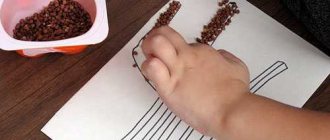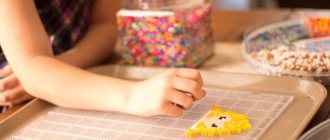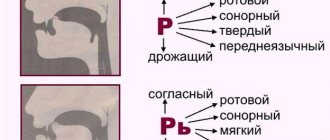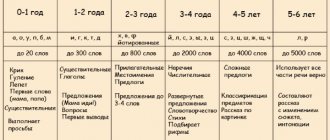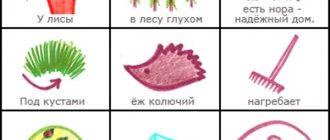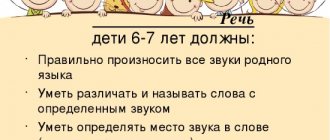Games and exercises for developing fine motor skills of preschoolers
Tatiana Radchenko
Games and exercises for developing fine motor skills of preschoolers
“The hand is the tool of all tools” (Aristotle)
Fine motor skills of the hands interact with such higher properties of consciousness as attention, thinking, optical-spatial perception (coordination, imagination, observation, visual and motor memory, speech. The development of fine motor skills is also important because the child’s entire future life will require the use of precise, coordinated movements of the hands and fingers, which are necessary to dress, draw and write, as well as perform a wide variety of everyday and educational activities.
One of the skills that should be developed by the time a child goes to school is the development of precise movements (fine motor skills).
Primary school teachers constantly note that the biggest problem for many children is their unprepared hand for writing. What is the reason for graphical unpreparedness for learning to write? There are two reasons:
1. Insufficient development of small muscles of the hand (“physiological unpreparedness”)
2. Lack of skill in performing graphic movements (“psychological unpreparedness”)
In order for a child to write beautifully and accurately, it is necessary to develop coordinated movements of the small muscles that make up the hand. The writing technique requires coordinated work of the small muscles of the hand and the entire arm, as well as well-developed visual perception and voluntary attention. Lack of preparation for writing, insufficient development of fine motor skills, visual perception, and attention can lead to a negative attitude toward learning and an anxious state in the child at school.
Parents should be wary if their child actively turns a sheet of paper when drawing or coloring. In this case, the child replaces the ability to change the direction of the line with the help of subtle finger movements by turning the sheet.
The whole set of exercises for the development of fine motor skills can be divided into three parts:
Finger gymnastics.
• Exercises for fingers and hands using various objects;
• Practicing graphic skills.
Preparing the hand for writing begins long before the child enters school. It is very important to develop the skills necessary to master writing, as well as create conditions for the child to gain practical experience. And here such familiar exercises as everyone can help:
Modeling.
Just a wonderful activity for developing fine motor skills in preschoolers. Before sculpting, be sure to let a child of any age knead the plasticine. This is a very useful exercise for developing fine motor skills. In this regard, ordinary domestic plasticine is much more useful than soft imported plasticine.
Exercises with paper:
1) kneading - developing hand strength (after this you will get a “ball” that can be thrown into the basket from a distance,
2) tear (development of correlating movements) - grab the sheet with the fingers of both hands and pull in different directions.
3) make appliqués from paper balls (crumple the paper, tear it into strips, then tear the strips into squares, roll each square on your palm into a ball, lay out a silhouette with balls - for example, a cat, a lamb, a cloud)
Sorting small items
It is very important that the baby does this either with a pinch (with three fingers), or using the “tweezer grip” method, that is, he grabs with two fingers - the thumb and forefinger. At the same time, the other fingers should be tucked in and not interfere. Show the baby the correct way to perform this exercise.
Cutting with scissors.
Cutting out various figures from old postcards and magazines is a useful and exciting activity for future first-graders.
Older preschoolers begin to master the skills of silhouette cutting without preliminary drawing or preparing a contour line.
Games - Maria Montessori lacing:
Games with lacing also develop the eye, attention, strengthen the fingers and the entire hand (fine motor skills, and this in turn affects the formation of the brain and the development of speech. And also, which is not unimportant, lacing games indirectly prepare the hand for writing and develop perseverance.
The following exercises will help you develop your graphic skills:
Drawing lines, curly paths
– The child is asked to draw a figured path, connecting the hatching line. When walking along the path, the child should try to follow all the bends and turns of the lines as accurately as possible.
– The child is asked to draw a line in the middle of the figured path. When completing the task, you must pay special attention to the fact that you cannot touch the walls (especially in mazes, the line should go in the middle of the path. The pencil does not come off the paper, and the sheet of paper does not turn over.
Along the contours
The child is asked to connect the dots to create a complete drawing.
Hatching with different directions of hand movement
Hatching is one of the most important exercises. Hatching rules:
• Hatch only in the specified direction.
• Do not go beyond the contours of the figure.
• Maintain parallel lines.
• Do not bring strokes closer together, maintain distance
The child is asked to perform various types of hatching according to samples: vertical (from top to bottom, horizontal (from left to right), oblique, “balls” (circular movements of the hand, semicircles. Lines of complex shapes should be made with one movement of the hand. Hatching should initially be large, as they become more As the child learns to perform them, their size decreases, and attention should be paid to the decrease in the amplitude of movements of the hand.
Drawing by points
The child is asked to connect the dots according to the instructions below the picture. The tasks should be completed as follows: the pencil or pen does not come off the sheet of paper, the sheet is fixed, and its position does not change.
Draw a figure using dots, as in the example.
Coloring
A simple and effective way to prepare your hand for writing is through coloring books. By coloring favorite pictures, the child learns to hold a pencil in his hand and uses pressure. This activity trains the small muscles of the hand, making its movements strong and coordinated. It is recommended to use colored pencils rather than felt-tip pens.
You can invite your child to copy the drawings they like onto transparent paper. Ornaments and patterns are very useful, since they contain a large number of curved lines, which is a good preparation for the child’s hand to write capital letters.
Stroke
It is very good to trace stencils, templates, trace using figured rulers, three-dimensional and planar images of objects. You can trace anything that comes to hand: the bottom of a glass, an inverted saucer, your own palm, a spoon, etc.
All these exercises bring triple benefits to the child:
firstly, they develop fine motor skills of his hands, preparing him for mastering writing,
secondly, they develop his artistic taste, which is useful at any age,
thirdly, child physiologists claim that a well-developed hand will “pull” the development of intelligence.
Offer these activities to your children every day!
Such comprehensive training perfectly develops fine motor skills of the hands, and the child will be well prepared for school, his hand movements will be more confident, and school activities will not be so tiring for the child.
